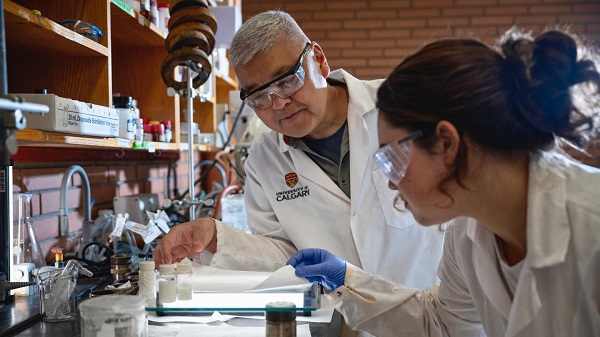Health
‘Shocking cover-up’: DOJ lawyers committed fraud in vaccine injury case, CHD attorney alleges in motion

From LifeSiteNews
By Brenda Baletti, Ph.D., The Defender
“The evidence submitted in support of the motion clearly shows that attorneys from the Department of Justice concealed and misrepresented highly relevant information from the special masters in the Vaccine Injury Compensation Program and the judges in the courts”
Rolf Hazlehurst, a Children’s Health Defense (CHD) staff attorney and father of a son with autism, filed a motion in federal court on April 2 alleging lawyers representing the U.S. Department of Health and Human Services (HHS) fraudulently concealed evidence that vaccines can cause autism.
In a motion filed in the U.S. Court of Federal Claims, Hazlehurst alleged that U.S. Department of Justice (DOJ) lawyers who represented HHS in vaccine injury cases repeatedly defrauded the judicial system – from the National Vaccine Injury Compensation Program (NVICP) to the U.S. Supreme Court.
That fraud led to thousands of families of vaccine-injured children being denied the right to compensation and the right to have their cases heard, according to the motion.
“This motion makes very serious and well-substantiated allegations of a massive scheme of fraud on the courts,” said Kim Mack Rosenberg, CHD general counsel who also is of counsel to Hazlehurst in the federal case.
“The evidence submitted in support of the motion clearly shows that attorneys from the Department of Justice concealed and misrepresented highly relevant information from the special masters in the Vaccine Injury Compensation Program and the judges in the courts,” Mack Rosenberg told The Defender.
Hazlehurst’s son Yates regressed into autism after being vaccinated as an infant. In the early 2000s, his family and thousands of others filed cases seeking compensation for vaccine-induced autism through the NVICP.
The program consolidated all of the petitions into the Omnibus Autism Proceeding (OAP) and selected six representative “test cases” – of which Yates’ was the second – as the basis for determining the outcome of the remaining 5,400 cases.
Unbeknownst at the time to the petitioners and the NVICP special masters, the DOJ’s star expert medical witness, Dr. Andrew Zimmerman informed DOJ attorneys during the ongoing omnibus proceedings that he had reversed his original opinion and determined that vaccines can and do cause autism in some cases.
In what Hazlehurst alleges was “a shocking cover-up,” instead of allowing Zimmerman to share his revised opinion, the DOJ attorneys relieved Zimmerman of his duties as a witness.
However, they continued to use excerpts from his unamended written opinion to make their case that vaccines did not cause autism – misrepresenting his position and committing “fraud on the court.”
According to the motion, the DOJ’s first act of fraud snowballed into a scheme of deception with far-reaching implications in which DOJ attorneys repeatedly misrepresented Zimmerman’s opinion and concealed other evidence that emerged during the test case hearings in the OAP in subsequent cases before multiple courts.
“As a result, thousands of cases in the Omnibus Autism Proceeding were denied compensation and the impact beyond the OAP is enormous,” Mack Rosenberg said. “This fraud affected the Vaccine Injury Compensation Program – especially the Omnibus Autism Proceeding – the Court of Federal Claims, the Court of Appeals for the Federal Circuit and even the U.S. Supreme Court.”
Hazlehurst said he is “asking the court to give this motion the serious attention it deserves.” He added, “At a minimum, the court should allow discovery and hold a hearing on this motion.”
Overturning a ruling due to fraud on the court is an extraordinary remedy reserved for extraordinary cases but according to Hazlehurst, “This motion we filed shows that this indeed is an extraordinary case.”
The DOJ has until April 30 to respond to the motion.
CHD CEO Mary Holland told The Defender, “Vaccines most definitely do cause autism, and the government has been lying about this reality for decades.”
Holland added:
With others, I published a law review article in 2011 showing that the government absolutely knew that vaccines cause autism – and yet they have covered it up and lied about it since the inception of the Vaccine Injury Compensation Program.
How many hundreds of thousands of children and families would have been spared the heartaches and crushing financial burdens of autism had the government come clean?
‘Exceptionally difficult’ to obtain compensation through NVICP
In the late 1980s, a substantial number of lawsuits for vaccine injuries related to Wyeth’s (now Pfizer) DPT vaccine, combined with “grossly insufficient compensation” for victims of vaccine injury, threatened the vaccine program’s viability.
In response, Congress passed the National Childhood Vaccine Injury Act of 1986, which established the “vaccine court.” The law gave the pharmaceutical industry broad protection from liability and proposed to compensate vaccine-injured children through the new NVICP.
The NVICP originally was designed to be a “swift, flexible, and less adversarial alternative to the often costly and lengthy civil arena of traditional tort litigation.”
To receive compensation, parents file a claim with the program.
The Court of Federal Claims (which oversees the program) appoints “special masters” – typically lawyers who previously represented the U.S. government – to manage and decide the individual claims. Attorneys may represent the petitioners, and the DOJ represents HHS.
NVICP proceedings are more informal than a typical courtroom. Unlike regular court proceedings, petitioners in the “vaccine court” have no right to discovery.
If a petitioner files a claim for a vaccine covered under the program and listed on the Vaccine Injury Table – the list of known vaccine side effects associated with certain vaccines within set time frames – it is presumed that a vaccine caused the petitioner’s injury and the petitioner is eligible for compensation without proof of causation.
However, if a petitioner experiences an “off-table injury” – an injury not listed on the table or that didn’t happen in the recognized injury time frame – the petitioner must prove by “a preponderance of evidence” that the vaccine caused the injury. Evidence includes medical records and expert witness testimony.
Claims must be filed within three years of the first symptom or two years of death.
Petitioners must provide a medical theory of the cause, a sequence of cause and effect, and show a temporal relationship between vaccine and injury.
However, the NVICP does not specify the required volume and type of evidence, so meeting the “preponderance of evidence” standard is largely at the discretion of the special master.
Petitioners can appeal NVICP cases to the Court of Federal Claims, the Court of Appeals for the Federal Circuit and ultimately to the U.S. Supreme Court.
It is “exceptionally difficult” to obtain compensation within the NVICP, Hazlehurst told The Defender. The proceedings are often turned into drawn-out, contentious expert battles and the backlog of cases is substantial.
The Vaccine Act of 1986 is unjust for petitioners, Hazlehurst alleges. And that injustice reached its zenith with the OAP, when the DOJ perpetrated fraud right under the noses of the special masters, signaling the beginning of the fraud on the courts that continues to this day.
Hazlehurst told The Defender he hopes his motion will shed light on the damage inflicted by this law and that it will ultimately help end the autism epidemic.
“The Vaccine Act of 1986 is one of the fundamental causes of the autism epidemic,” Hazlehurst said. “Understanding why this is true, and how the United States Department of Justice perpetrated fraud upon the courts, including the Supreme Court of the United States, is the key to ending the autism epidemic.”
A short history of the autism omnibus proceedings
By 2002, to address a “massive influx” of petitions alleging vaccine-induced autism, the Office of Special Masters combined over 5,000 claims into the OAP to determine whether vaccines cause autism and if so, under what conditions.
Initially, the NVICP planned to investigate causation issues and apply those general findings to individual cases. However, the program changed its strategy and instead selected six “test cases” by which it would examine the evidence for injuries caused by the measles mumps rubella (MMR) vaccine, thimerosal-containing vaccines (TCV), or a combination of both.
Then it would apply the findings of the test cases to other similar cases.
In doing so, Hazlehurst alleges, the court conflated general causation evidence with specific causation evidence from a few cases, without allowing for rules of discovery or evidence that would apply in an actual court.
This, Hazlehurst said, “was a recipe for disaster” as each test case was then used to determine the outcome for the remaining 5,000 cases.
Three cases – Cedillo v. HHS, Hazlehurst v. HHS, and Poling v. HHS – are at the center of the alleged fraud by the DOJ.
Fraud #1: the Zimmerman testimony
Hearings for the first OAP test case, Cedillo v. HHS, began in 2007. Zimmerman had worked with the DOJ to prepare an expert report on behalf of HHS finding that Michelle Cedillo’s autism had likely not been caused by the MMR vaccine.
Zimmerman later wrote in a 2018 affidavit that he attended the Cedillo hearing and listened to the testimony of Dr. Marcel Kinsbourne, another world-renowned expert in pediatric neurology.
On that basis, Zimmerman stated, he decided to clarify his written expert opinion about Michelle Cedillo, concerned it would be taken out of context.
Zimmerman spoke with DOJ attorneys to clarify that his expert opinion in the Cedillo case “was not intended to be a blanket statement as to all children and all medical science,” according to the 2018 affidavit.
He specified that advances in science, medicine and his own clinical research had led him to believe there were exceptions in which vaccinations could cause autism.
He also referred the attorneys to a paper he published with colleagues in 2006, the Poling paper, describing the case of an unidentified child who suffered regressive autism following vaccine adverse reactions. The paper suggested a possible association between mitochondrial dysfunction, vaccinations and regressive autism.
After communicating this evidence to DOJ attorneys, the DOJ dismissed Zimmerman as a witness but continued to use his written opinion as general causation evidence.
The DOJ was also allowed to use that report, submitted in one test case, as general causation evidence in other test cases.
None of the petitioners in the test cases could cross-examine Zimmerman, because he was no longer a witness. This was only possible because the federal rules of evidence do not apply in NVICP proceedings.
Yates’ case, Hazlehurst v. HHS, was the second test case in the OAP. His treating neurologist, Dr. Jean-Ronel Corbier testified Yates’ autism was likely caused by a genetic predisposition combined with an environmental insult in the form of vaccinations administered when Yates was ill. (Yates was a patient of Zimmerman in 2002.)
Corbier’s theory of causation in Yates was similar to the theory developed by Zimmerman in the Poling paper and shared with DOJ attorneys.
Yet, despite knowing Zimmerman had concluded that in a subset of children like Yates, vaccines can cause autism, the DOJ “intentionally and fraudulently” misrepresented Zimmerman’s expert testimony in its closing statements in Yates’ case, Hazlehurst alleges.
DOJ attorneys selectively quoted Zimmerman’s expert report from the Cedillo case, telling the court that Zimmerman found there was “no sound evidence to support a causative relationship with exposure to both or either MMR and/or mercury,” when Zimmerman had explicitly told the DOJ that his opinion was the opposite, according to the affidavit.
Fraud #2: the Hannah Poling case
Three weeks after closing arguments in Yates’ case, the DOJ quietly conceded Hannah Poling’s case, which was on the verge of becoming the fourth test case.
Hannah regressed into autism over several months after being vaccinated against nine diseases at one doctor’s visit.
In 2003, Poling’s father, Jon, a physician and trained neurologist, and mother, Terry, an attorney and nurse, filed an autism petition against HHS under the NVICP for their daughter’s injuries.
Jon Poling was a co-author of the 2006 paper with Zimmerman that analyzed an unnamed child, later revealed as Hannah Poling, who had a mitochondrial disorder – a condition with which Yates was later diagnosed.
In 2007, just three weeks after the lead DOJ attorney misrepresented Zimmerman’s opinion during the hearing in Hazlehurst, the same DOJ attorney submitted a report to the special masters conceding that in the case of Poling v. HHS, Hannah’s “regressive encephalopathy with features of autism spectrum disorder” (i.e., regressive autism) was caused by a vaccine injury, based upon a preponderance of the evidence standard.
This was the same neurological diagnosis Zimmerman had made for Yates in 2002.
According to court documents, if HHS had not conceded Poling, Poling v. HHS would have been designated as a test case. However, because the DOJ conceded the case, it was taken out of the omnibus and the DOJ had the case records sealed – although they were later leaked to the press and published in the Huffington Post in 2008.
In March 2008, Hannah’s parents moved to make the proceedings transparent and available to the public, but the DOJ opposed the motion and the NVICP deferred a ruling on the motion for 60 days.
During those 60 days, the DOJ filed amendments to its report conceding the Poling case. It retroactively changed the basis for compensation to say that Hannah had a “table injury.”
This meant that instead of conceding that the petitioners had proven with a preponderance of evidence that the vaccines caused her autism, they said she had a presumptive injury on the vaccine table, in which causation is presumed.
By conceding the Poling case, opposing the parents’ motion for complete transparency and changing the basis for compensation, the DOJ was able to conceal fraud and critical material evidence of how vaccines cause autism, according to Hazlehurst.
Fraud #3: appellate courts and the U.S. Supreme Court
On Feb. 12, 2009, the special masters denied compensation in the first three cases. They found the petitioners failed to establish causation between MMR or TCV vaccines and autism.
In Hazlehurst’s case, the NVICP explicitly relied on the portion of Zimmerman’s expert report that DOJ attorneys misrepresented.
The Hazlehursts appealed to the Court of Federal Claims and the Court of Appeals for the Federal Circuit, both of which upheld the special master’s decision – by relying on Zimmerman’s misrepresented opinion and knowingly fraudulent statements made by a DOJ attorney, according to Hazlehurst.
Those prior decisions directly influenced the U.S. Supreme Court’s decision in the Bruesewitz v. Wyeth.
In that case, Wyeth, now Pfizer, argued that a decision favoring the Bruesewitz family – who was attempting to sue the company for their daughter’s vaccine injury – would lead to a “flood of frivolous lawsuits,” including by the families from the omnibus.
Amicus briefs from the American Academy of Pediatrics, GlaxoSmithKline, Merck and Sanofi Pasteur on behalf of Wyeth relied on Hazlehurst v. HHS and other OAP decisions that were based on the misrepresentation of Zimmerman’s testimony that there was “no scientific basis” that vaccines cause autism.
The Supreme Court ruled that the National Childhood Vaccine Injury Act, and the NVICP it created, preempt all design-defect claims against vaccine manufacturers by individuals seeking compensation for injury or death.
In oral arguments and in their written opinions, the justices explicitly cited the portions of the amicus briefs citing Hazlehurst v. HHS and other OAP rulings that relied on the DOJ misrepresentations in their rulings.
Since that ruling, the special masters have continued to rely on the DOJ’s fraudulent claims to deny compensation to families filing complaints in the NVICP.
Robert F. Kennedy Jr., CHD chairman on leave, and Hazlehurst in September 2018 filed a complaint with the DOJ Office of Inspector General outlining what they then knew about the DOJ’s fraud during the OAP.
The DOJ Office of Professional Misconduct investigated and responded in a June 2019 letter that it found no wrongdoing.
In that letter, however, the Office of Professional Responsibility conceded the DOJ had in fact kept Zimmerman’s testimony while dismissing him as a witness in order to avoid creating the appearance that he had changed his opinion and to prevent the petitioners from cross-examining him, according to Hazlehurst.
The ‘fraud on the court’ doctrine
It has taken 17 years, Hazlehurst said, since the DOJ’s first alleged act of fraud upon the court, for him to gather all of the admissible evidence necessary to “connect the dots and reveal the DOJ’s web of deceit” to make this claim under the “fraud on the court” doctrine.
Under this doctrine, codified as Rule 60(d)(3) in the rules of the Court of Federal Claims, there is no time limit for the court to overturn a judgment made on the basis of fraud on the court.
The petitioner must demonstrate that there was fraud, intent to defraud and that the fraud affected more than one instance of litigation – putting the integrity of the judicial process at stake.
Hazlehurst alleges DOJ attorneys committed fraud by knowingly making false statements and offering evidence they knew to be false and that they did not take remedial action to disclose information they knew to be false and misleading to the court.
The special masters themselves have an obligation to consider all relevant evidence, but didn’t, in this case, Hazlehurst said. Instead, they ignored the contradictions in Zimmerman’s opinions and ignored the Poling evidence.
This is particularly problematic for NVICP cases, where petitioners can’t conduct meaningful discovery or cross-examination and the special masters’ oversight is the only meaningful safeguard to prevent the DOJ’s abuse of power, according to Hazlehurst.
“There is nothing fair about a government proceeding where the government controls the admissibility of evidence,” he said.
Hazlehurst said that by forcing people injured by vaccines into an administrative program, petitioners are deprived of the basic constitutional rights to due process and equal protection under the law. “It should be declared unconstitutional,” he said.
This article was originally published by The Defender — Children’s Health Defense’s News & Views Website under Creative Commons license CC BY-NC-ND 4.0. Please consider subscribing to The Defender or donating to Children’s Health Defense.
Health
Leslyn Lewis urges Canadians to fight WHO pandemic treaty before it’s legally binding

From LifeSiteNews
Conservative MP Leslyn Lewis is urging Canadians to demand a parliamentary debate on the WHO Pandemic Agreement, highlighting risks to national sovereignty.
Conservative Member of Parliament (MP) Leslyn Lewis called on Canadians to petition against the World Health Organization’s (WHO) pandemic treaty before it becomes legally binding.
In an October 23 post on X, Lewis encouraged Canadians to demand that politicians debate the WHO Pandemic Agreement before it becomes law after warnings that the treaty could undermine national freedom and lead to global surveillance.
“I have raised red flags about its implications on Canada’s health sovereignty and the federal government’s willingness to enter a legally binding treaty of this weight without any input from Parliament,” she declared.
In May, Canada, under Liberal Prime Minister Mark Carney, adopted the treaty despite warnings that the agreement gives the globalist entity increased power in the event of another “pandemic.”
However, Lewis revealed that since the agreement has yet to be officially signed, Canada is not bound to it and can still make amendments.
“We are now in a critical window of opportunity to ask tough questions and debate the treaty before it is signed by the Minister of Foreign Affairs and binds our nation,” she explained.
Lewis encouraged Canadians to sign a petition calling for a debate of the agreement as well as contacting their local MPs to request a parliamentary review of the treaty.
Lewis revealed that Canadians’ persistent opposition to the treaty has already resulted in some of the more dangerous clauses, including restricting free speech, freedom of movement, and government surveillance, being removed from the final agreement.
“Thanks to the engagement of countless Canadians and concerned citizens around the world, the most extreme provisions in the WHO Pandemic Treaty were removed — these measures would have undermined national healthcare sovereignty and given international bureaucrats sweeping powers,” Lewis declared.
“The removal of provisions on vaccine mandates, misinformation and disinformation, censorship requirements, travel restrictions, global surveillance, and mandatory health measures happened because people paid attention and spoke up,” she continued.
Among the most criticized parts of the agreement is the affirmation that “the World Health Organization is the directing and coordinating authority on international health work, including on pandemic prevention, preparedness and response.”
While the agreement claims to uphold “the principle of the sovereignty of States in addressing public health matters,” it also calls for a globally unified response in the event of a pandemic, stating plainly that “(t)he Parties shall promote a One Health approach for pandemic prevention, preparedness and response.”
Business
Bill Gates walks away from the climate cult

Billionaire Bill Gates — long one of the loudest voices warning of climate catastrophe — now says the world has bigger problems to worry about. In a 17-page memo released Tuesday, the Microsoft co-founder called for a “strategic pivot” away from the obsessive focus on reducing global temperatures, urging leaders instead to prioritize fighting poverty and eradicating disease in the developing world. “Climate change is a serious problem, but it’s not the end of humanity,” Gates wrote.
Gates, 70, argued that global leaders have lost perspective by treating climate change as an existential crisis while millions continue to suffer from preventable diseases like malaria. “If I had to choose between eradicating malaria and preventing a tenth of a degree of warming, I’d let the temperature go up 0.1 degree,” he told reporters ahead of next month’s U.N. climate conference in Brazil. “People don’t understand the suffering that exists today.”
For decades, Gates has positioned himself as a leading advocate for global climate initiatives, investing billions in green energy projects and warning of the dangers of rising emissions. Yet his latest comments mark a striking reversal — and a rare admission that the world’s climate panic may have gone too far. “If you think climate is not important, you won’t agree with the memo,” Gates told journalists. “If you think climate is the only cause and apocalyptic, you won’t agree with the memo. It’s a pragmatic view from someone trying to maximize the money and innovation that helps poor countries.”
The billionaire’s change in tone is sure to raise eyebrows ahead of the U.N. conference, where climate activists plan to push for new emissions targets and wealth transfers from developed nations. Critics have long accused Gates and other elites of hypocrisy for lecturing the public about fossil fuels while traveling the globe on private jets. Now, Gates himself appears to be distancing from the doomsday rhetoric he once helped spread, effectively admitting that humanity faces more immediate moral imperatives than the weather.
(AP Photo/Alex Brandon)
Stunning Climate Change pivot from Bill Gates. Poverty and disease should be top concern.
-

 Alberta8 hours ago
Alberta8 hours agoFrom Underdog to Top Broodmare
-

 National2 days ago
National2 days agoCanadian MPs order ethics investigation into Mark Carney’s corporate interests
-

 National2 days ago
National2 days agoCanada’s NDP is now calling women ‘non-males’
-

 Alberta2 days ago
Alberta2 days agoNobel Prize nods to Alberta innovation in carbon capture
-

 Business1 day ago
Business1 day agoCanada’s attack on religious charities makes no fiscal sense
-

 International19 hours ago
International19 hours agoPrince Andrew banished from the British monarchy
-

 Business19 hours ago
Business19 hours ago“We have a deal”: Trump, Xi strike breakthrough on trade and fentanyl
-

 MxM News2 days ago
MxM News2 days agoTrump ‘Grateful’ For Bill Gates Pivot, Declares Victory Over ‘Climate Change Hoax’






